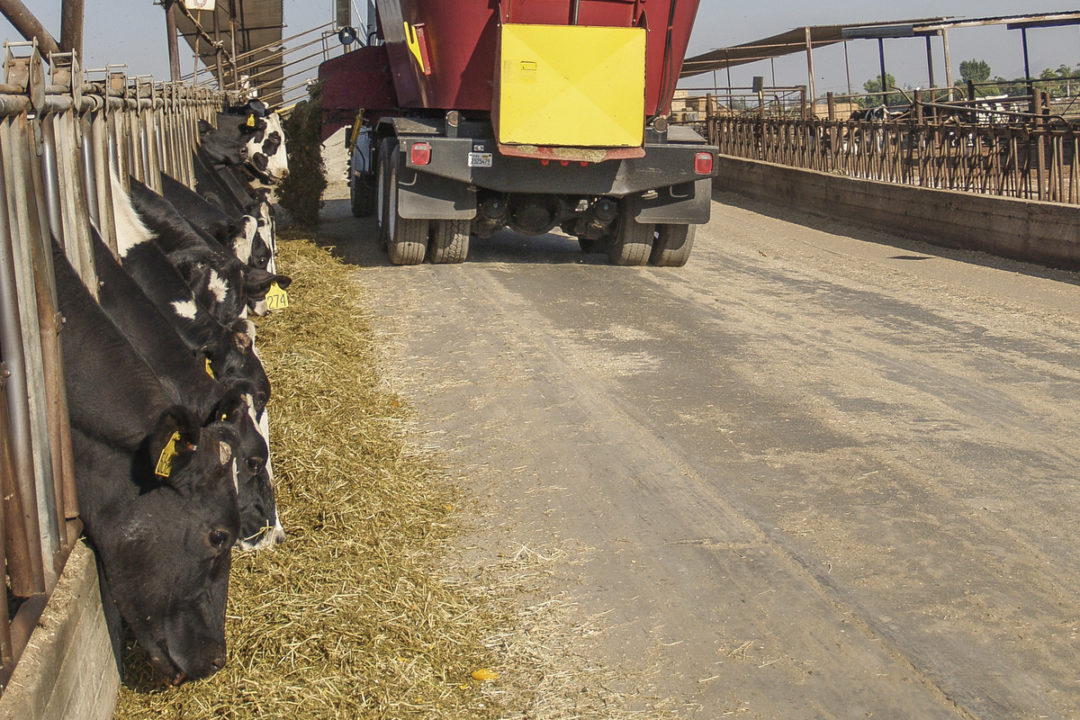The dry period is a time of rest and relaxation for the dairy cow. While her body continues to finish growing a calf, other organs are recovering from the lactation that has just been completed and preparing for another year of milk production. This change and preparation isn’t limited to only the udder; the rumen is also undergoing changes which will perhaps have just as much impact on the new lactation as ensuring proper udder health. Enhancing proper rumen health will make sure these cows are able to successfully transition from the dry pen into lactation.
The cause of metabolic disease
Dairy producers know and recognize the physical limitations of dry matter intake (DMI) during the dry period. As the calf continues to grow inside the uterus, the space in the abdomen that was once utilized by the rumen for feed consumption is reduced. This coupled with a more forage-based ration that takes longer to break down by the rumen microbes further suppresses DMI.
Feeding cattle is really about feeding the bugs within the rumen and letting them provide the cow with the nutrients they will use. The ingredients in the ration impact the number and classes of microorganisms, which then impacts the volatile fatty acid (VFA) profile, which can then affect the physical structure of the rumen.
By feeding a more forage-based diet, the amount of butyrate decreases. With less butyric acid, the VFA that is critical for papillae development and proliferation, the overall absorptive capacity of the rumen, may decrease by up to 25% during the dry period. With less DMI and less absorptive capacity of the rumen coupled with increasing energy demands with the initiation of colostrogenesis and the completion of fetal development, the risk of falling into negative energy balance becomes inevitable.
Parturition induces the initiation of lactation, which puts further strain on the energy demands of the cow. As the cow’s body responds to the increase in energy needs, her energy stores are mobilized. This utilization of fat to produce energy, while effective, does have negative consequences in the form of the production of ketone bodies. These ketone bodies suppress appetite, which can exacerbate appetite suppression. In order to increase the energy of the cow, more concentrates, which have more energy, are added to the ration. The change in feed ingredients alters the microbial population and, if not done correctly, can increase the risk of ruminal acidosis.
Managing the bugs for healthy rumen
By changing the diet from a forage-based diet to a diet higher in grain and energy, we also change the bacteria in the rumen. Bacteria that break down starch in the diet produce more propionic acid, the VFA which can most readily be converted into glucose and butyrate. This increases the growth and development of the papillae and improves absorption of nutrients.
But in addition to the increase in propionic acid, there is also an increase in lactic acid, a much stronger acid that decreases the pH of the rumen. A rapid decrease in the rumen pH may kill off many other classes of bacteria, allowing these lactic acid bacteria to proliferate and cause a more severe rumen acidosis. A case of acidosis in the fresh period may damage the rumen, reducing its absorptive capacity for over six months.
Rumination, or cud chewing, is one of the natural mechanisms for combating low pH in the rumen. As a cow chews her cud, saliva which is high in bicarbonate is produced and swallowed, buffering the pH of the rumen. If insufficient amounts of effective forage are included in the ration to stimulate cud chewing, this safety mechanism is lost.
Feeding bicarbonate in the ration to make up for the decrease in endogenous production is one strategy to protect the rumen from damage. Direct-fed microbials or DFMs are an emerging method of protection as well.
Megasphaera elsdenii
Besides having microbes that are able to break down the feeds provided in the ration, the rumen also contains bacteria that consume the byproducts produced by bacteria. Megasphaera elsdenii is one such bacteria. As levels of lactic acid begin increasing in the rumen, the bacteria numbers increase, utilizing the lactic acid as its primary source for growth. The utilization of lactic acid by the bacteria minimizes the drop in pH, improving the health of the rumen and reducing the risk of acidosis.
After consuming the lactic acid, the Megasphaera elsdenii produces butyrate, the VFA that feeds the rumen papillae and improves the absorption of nutrients across the rumen. These lactic acid-utilizing bacteria are generally much slower at proliferating than their lactic acid-producing counterparts. This can create a situation where the bacteria consuming lactic acid become overwhelmed and unable to keep up.
Commercially available products offer producers the ability to inoculate cattle with a purified strain of Megasphaera elsdenii, jump-starting the levels that are available in the rumen at the time of transition. By increasing the population of the lactic acid-utilizing bacteria, the cow is able to avoid having an excessive buildup of lactic acid and is better able to stabilize the pH of the rumen.
The changes that occur during the transition period in the rumen of the cow will impact her during the entire lactation. The quicker that cows are able to consume adequate energy and absorb the nutrients through the rumen papillae, the less risk there is for metabolic disorders such as ketosis. However, pushing too much energy without ensuring that the cow has the correct bacteria may lead to acidosis, which can have lactation-long negative effects. While the key to a healthy transition may be in the rumen, the key to a healthy rumen is having the correct bacteria at the correct time.






